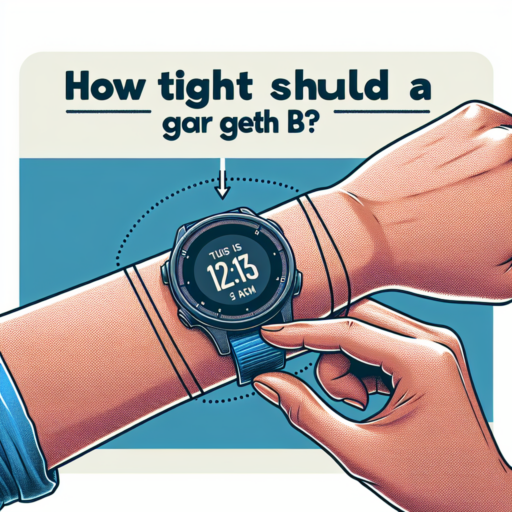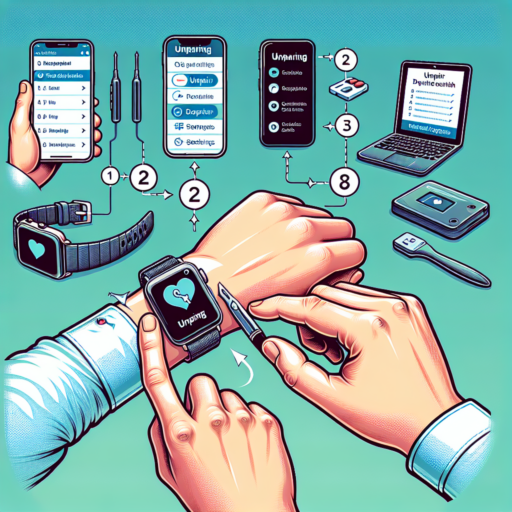Understanding the Perfect Fit: How Tight Should Your Garmin Watch Be?
Finding the ideal tightness for your Garmin watch is essential for both comfort and functionality. The question of «How tight should your Garmin watch be?» often arises especially for new users. The perfect fit ensures that the heart rate monitor and other sensor-based features operate effectively, without causing uncomfortable pressure or skin irritation over time. An optimal fit is one that balances snugness and comfort, allowing for accurate data tracking without compromising on ease of wear.
Firstly, it’s important to understand that your Garmin watch should sit comfortably on your wrist, just above the wrist bone. The fit should be secure enough so the watch doesn’t move around during activities, yet not so tight that it restricts blood flow. Ideally, you should be able to fit a finger snugly between the strap and your wrist. This ensures that the sensors maintain continuous contact with your skin for accurate readings while leaving enough room to prevent any discomfort.
Moreover, consider the material of the band and its adjustability options. Silicone bands typically offer more flexibility and can comfortably stretch to accommodate natural wrist swelling during exercises or throughout the day. Assessing the tightness of your watch band regularly and making slight adjustments can make a significant difference in both the comfort and the accuracy of the data collected.
The Importance of Getting the Right Fit for Your Garmin Watch
When it comes to optimizing your experience with a Garmin watch, ensuring you have the right fit is crucial. Not only does a proper fit prevent discomfort during long periods of usage, but it also impacts the device’s functionality and your overall satisfaction. A watch that’s too loose might not track your activities accurately, while one that’s too tight could restrict blood flow and cause irritation.
Ensuring Accurate Activity Tracking
For athletes and fitness enthusiasts, the Garmin watch is a vital tool for tracking daily activities and monitoring progress. The accuracy of this data, however, is heavily dependent on how well the watch fits. A snug, but not restrictive fit, allows the sensors to maintain constant contact with your skin, ensuring more reliable data collection on your heart rate, calories burned, and sleep patterns. By getting the right fit, you’ll be able to trust the insights your Garmin watch provides, allowing for more precise adjustments to your training and lifestyle.
Maximizing Comfort and Avoiding Skin Issues
Beyond the technical reasons, the fit of your Garmin watch plays a significant role in your comfort and skin health. A watch that fits well minimizes the risk of skin irritation caused by friction or excessive moisture trapped between the band and your wrist. This is especially relevant for individuals who wear their watch 24/7 or during intense workout sessions. Thus, finding the right fit is not just about improving the device’s performance but also about ensuring a better and healthier user experience.
Step-by-Step Guide to Finding Your Ideal Garmin Watch Fit
Finding the perfect Garmin watch that aligns with your lifestyle and fitness goals doesn’t have to be daunting. With a myriad of options available, it’s all about narrowing down your preferences and understanding the features that will most benefit your daily routine. Follow this step-by-step guide to discover your ideal Garmin watch fit.
Identify Your Primary Use
The first step in our guide is to pinpoint exactly why you need a Garmin watch. Whether you’re an avid runner, a triathlon enthusiast, or simply looking for a smartwatch to keep you connected throughout the day, Garmin offers specific models designed to cater to your unique needs. Consider what activities you’ll be using your watch for the most, such as running, swimming, biking, or golfing, and use that as a starting point in your search.
Consider the Features
Once you’ve identified your primary use, it’s time to think about the features that are essential for your daily activities and fitness goals. Garmin watches come loaded with a variety of functionalities ranging from GPS tracking and heart rate monitoring to sleep analysis and smart notifications. Make a list of the must-have features that will enhance your workout and daily routine, and keep an eye out for watches that match your criteria.
Analyzing your daily activities and understanding the features that will best complement your lifestyle are crucial steps in finding your perfect Garmin watch fit. Remember, the ideal watch is one that not only meets your fitness demands but also integrates seamlessly with your daily life, providing a balance of functionality and convenience. Start with these steps, and you’ll be well on your way to selecting a Garmin watch that feels like it was tailor-made for you.
Common Fitting Mistakes to Avoid with Your Garmin Watch
When optimizing the fit of your Garmin watch, it’s essential to steer clear of common mishaps that can affect both comfort and the device’s performance. Understanding these pitfalls can enhance your user experience, ensuring your watch functions optimally during your daily routines or intense workout sessions.
Too Tight or Too Loose
One of the primary mistakes to avoid is wearing your Garmin watch either too tight or too loose. A strap that’s too tight can impede blood circulation, potentially affecting the heart rate sensor’s accuracy. On the other hand, a too loose fit might cause the watch to move excessively on your wrist, leading to inaccurate activity tracking. Finding that perfect snugness—not too tight, not too loose—is crucial for reliable data collection.
Incorrect Positioning on the Wrist
Another common error is incorrect positioning of the watch on the wrist. Your Garmin watch should be positioned approximately one finger width above your wrist bone. This placement is critical for the heart rate sensor to function accurately. Placing the watch directly on the wrist bone can cause discomfort and lead to erroneous heart rate readings.
In summary, ensuring the correct fit of your Garmin watch is not just about comfort; it directly impacts the device’s accuracy and performance. By avoiding these common fitting mistakes, you can vastly improve your Garmin watch experience, making every workout count.
Tips to Ensure Your Garmin Watch Fits Comfortably All Day
Wearing a Garmin watch should enhance your day-to-day life, not cause discomfort or distraction. Ensuring a perfect fit can improve the accuracy of tracking features while also ensuring comfort throughout the entire day. Here are some focused tips on achieving just that.
Find the Right Band Size
One crucial step towards comfort is choosing the right band size. Your Garmin watch should fit snugly around your wrist without feeling tight. It’s essential to leave just enough space to slide one finger under the band to prevent restriction of blood flow.
Adjust Throughout the Day
As your day progresses, your wrist might swell, especially after exercising or during high temperatures. Therefore, it’s wise to adjust the fit of your Garmin watch to accommodate any changes in wrist size. This ensures continuous comfort and accurate sensor readings no matter the activity or time of day.
Material Matters
The material of the watch band can also significantly impact comfort. Garmin offers a variety of band materials such as silicone, leather, and metal. Each has its unique feel, with silicone bands being more suited for exercise due to their flexibility and breathability. Selecting a band that aligns with your daily activities can greatly enhance overall wearability.
Adjusting Your Garmin Watch: A How-To Guide for Perfect Tightness
Getting the right fit for your Garmin watch is essential not just for comfort, but also for ensuring the device’s sensors work effectively to track your activity. Achieving perfect tightness may seem straightforward, but there are nuances to consider that can significantly enhance your Garmin watch wearing experience. Whether it’s your first Garmin or you’re adjusting a new model to fit, following a few simple guidelines will ensure your watch is both secure and comfortable on your wrist.
Understanding Your Garmin Watch Band
Before you start adjusting your Garmin watch, it’s critical to understand the type of band it has. Garmin offers a variety of band types, including silicone, leather, and metal. Each type has a specific mechanism for adjustment. Silicone bands typically feature a buckle and strap design, making them easy to adjust on the fly. Leather and metal bands might require the removal or addition of links or the use of a clasp system for fine adjustments. Recognizing your band type is the first step toward achieving the perfect fit.
Step-by-Step Adjustment
- For Silicone Bands: Insert the pin into the hole that best fits your wrist size. Ensure it’s snug but not too tight to avoid impacting circulation or causing discomfort over time.
- For Leather and Metal Bands: If your watch has a band that requires link adjustment, consider visiting a professional to remove or add links. This ensures a precise fit and minimizes the risk of damaging your watch.
- Testing the Fit: Once adjusted, wear your Garmin watch for a short period to assess comfort. The device should be tight enough not to move around on your wrist while still allowing your skin to breathe.
Adjusting your Garmin watch for perfect tightness is crucial for comfort and accurate data tracking. By understanding your band type and following the proper steps for adjustment, you’ll ensure your watch fits as if it were custom made for you. Remember, the goal is a secure fit that allows for skin ventilation and movement without the watch sliding up and down your wrist.
How Your Garmin Watch’s Fit Can Affect Its Performance and Accuracy
When it comes to utilizing your Garmin watch to its fullest potential, understanding the impact of its fit on performance and accuracy is crucial. A snug but comfortable fit ensures that the numerous sensors on your watch, including the heart rate monitor and GPS, operate efficiently. This direct connection with your skin is essential for accurate data collection, from tracking your heartbeats to mapping your run accurately.
Ensuring the perfect fit is not just about comfort; it directly influences the precision of the data collected. For instance, a watch that’s too loose might result in sporadic heart rate data, as the sensor must maintain consistent contact with your skin to monitor changes accurately. Similarly, the GPS functionality can be compromised if your watch shifts significantly during vigorous activities. Such discrepancies can lead to inaccurate workout data, affecting your training insights and progress tracking over time.
Tips for Adjusting Your Garmin Watch for Optimal Performance
- Wear it above your wrist bone: This position ensures the sensors have the best possible skin contact and reduces potential inaccuracies caused by skeletal movements.
- Not too tight, not too loose: The watch should feel secure without causing indentations on your skin or discomfort. A watch that’s too tight can restrict blood flow, influencing the heart rate sensor’s readings.
- Adjust for activities: Consider tightening your watch a notch for workouts or runs to prevent sliding, and loosen it slightly for everyday wear to maintain comfort and skin health.
The interplay between the fit of your Garmin watch and its operational excellence cannot be overstated. A correct fit not only elevates the comfort level but is instrumental in delivering precise data that Garmin users rely on. By paying close attention to how your watch is worn, you can significantly enhance both its performance and the accuracy of the health and fitness metrics it provides.
No se han encontrado productos.
Expert Advice: What to Do If Your Garmin Watch Feels Too Tight or Too Loose
When wearing a Garmin watch, achieving the perfect fit is crucial for comfort and functionality, especially during prolonged periods of wear or intense workouts. If your Garmin watch feels too tight or too loose, there are several steps you can try to improve the situation.
First, assess how your watch fits. A proper fit should be snug enough to keep the watch in place without moving around excessively but not so tight as to restrict blood flow or leave marks on your skin. If your Garmin watch is equipped with an adjustable band, experiment with different notch settings to find a more comfortable fit. For models that use a clasp system, ensure that it is securely fastened and adjusted to fit your wrist size perfectly.
If adjusting the band does not solve the issue, consider exploring alternative band materials. Garmin offers a wide range of bands made from various materials such as silicone, leather, and metal. Each material offers different levels of flexibility, weight, and comfort. Silicone bands, for example, are known for their lightweight and flexible properties, which might provide a more comfortable fit if your current band feels too tight or rigid.
Finally, proper wrist placement is key. Your watch should be positioned just above the wrist bone. This placement not only ensures optimal comfort but also allows the device to monitor your heart rate more accurately. If your watch feels too tight or too loose, it might simply be a matter of repositioning it on your wrist.
Frequent Questions Answered About Garmin Watch Fit and Comfort
When it comes to finding the perfect sports watch, Garmin stands out for its blend of functionality, technology, and comfort. A common concern for potential Garmin watch owners revolves around how these devices fit and feel during daily wear and vigorous activities. Understanding the nuances of Garmin watch fit and comfort can help ensure that your investment is both practical and enjoyable for everyday use and fitness routines.
How Do Garmin Watches Adjust to Different Wrist Sizes?
The design of Garmin watches accommodates a wide range of wrist sizes, thanks to adjustable straps that can be easily loosened or tightened. Garmin devices often come with silicone bands that offer a snug, yet comfortable fit, ensuring the watch remains stable without restricting movement or causing irritation. For those with very small or large wrists, Garmin provides alternative band options in various sizes and materials, including leather and metal, to further personalize the fit.
Are Garmin Watches Comfortable to Wear All Day?
Garmin watches are engineered for all-day wear. They are lightweight and feature ergonomically designed contours that complement the natural curve of your wrist. This thoughtful design minimizes discomfort during extended wear, even while sleeping or engaging in high-intensity workouts. Additionally, the breathable material of the standard bands helps to prevent sweat buildup, a common issue with continuous wear in fitness watches.
Can Garmin Watches Withstand Rigorous Exercise and Outdoor Activities?
Durability is a hallmark of the Garmin brand, with watches built to withstand the rigors of intense workouts and outdoor adventures. The construction features water-resistant materials, allowing wearers to engage in a variety of activities without concern for moisture damage. Likewise, the scratch-resistant screen and rugged build ensure that your Garmin can keep pace with your active lifestyle, from running and swimming to climbing and beyond.




